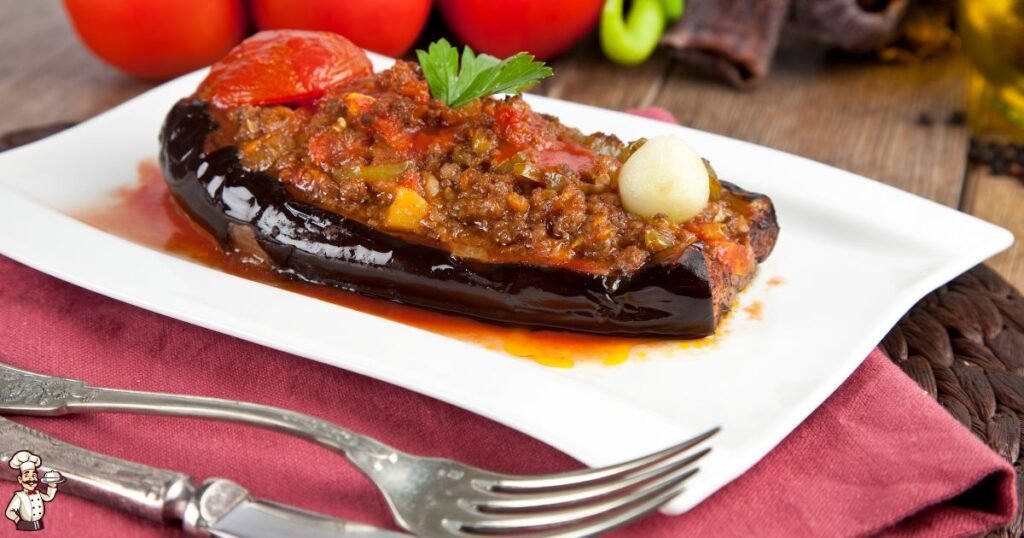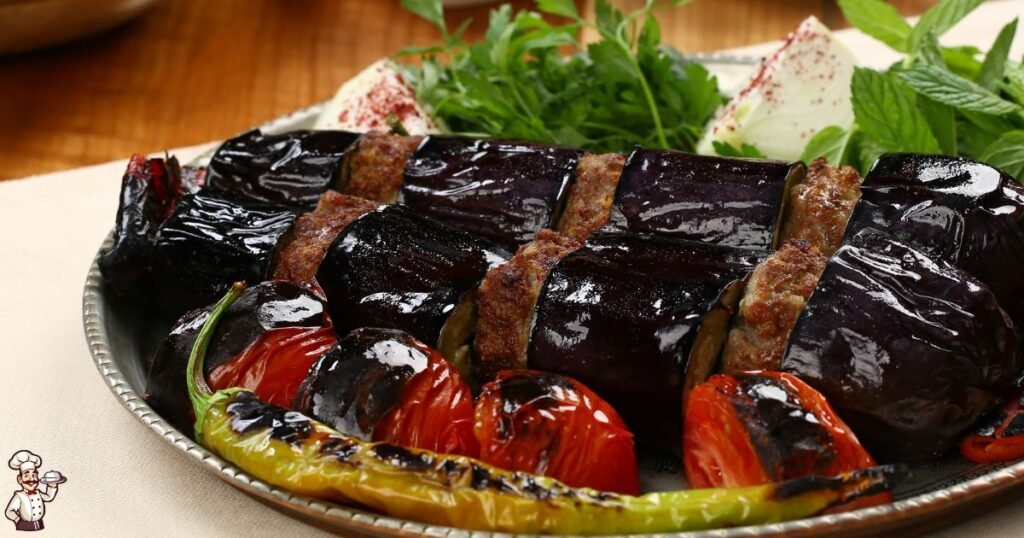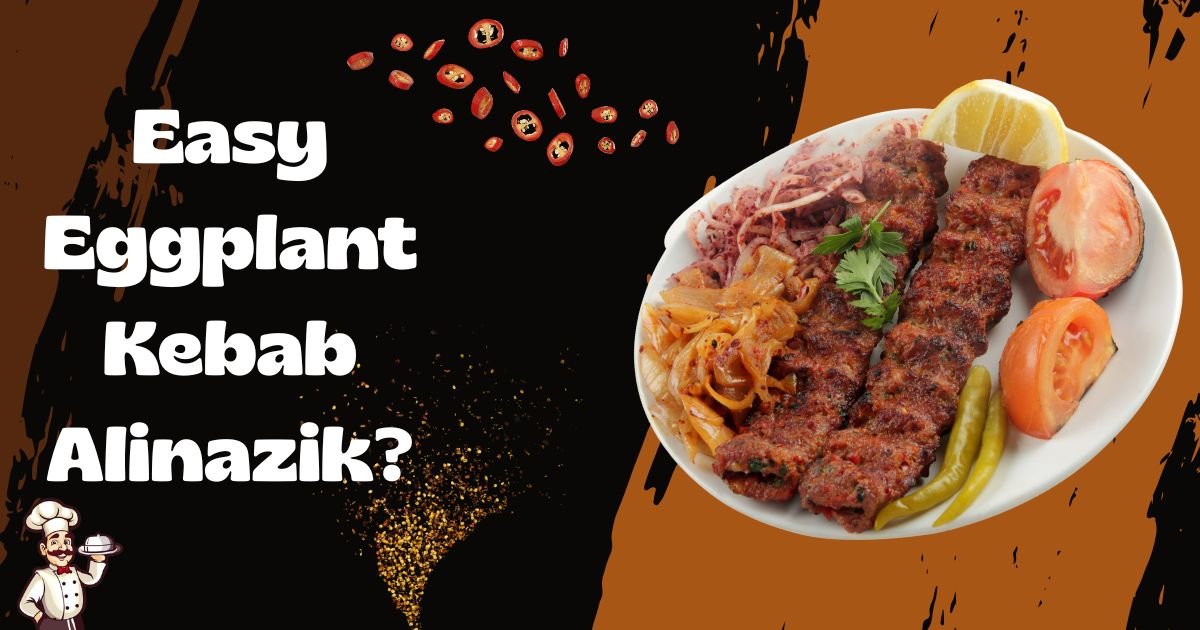One of the easiest dishes I’ve ever made at home is the beloved Ali Nazik, a rich and flavorful kebab from Turkey that brings the soul of Istanbul right to your kitchen. The base is a smokey eggplant puree that’s gently mixed with yogurt until it turns perfectly creamy. On top of this soft layer, you spoon tender lamb cubes that have been stewed slowly with onions, aromatic spices, and a touch of tomato paste—a true comfort dish. I’ve found that when served with warm bread or a side of buttery rice, it can completely transport you to the bustling restaurants of old-town Istanbul. With a few easy steps, it comes together in under an hour, making it a go-to for anyone craving a traditional Turkish dinner without spending the whole day cooking.
Ingredients Needed for Eggplant Kebab Alinazik
- For the base, I use 4 thick, soft eggplants, grilled until tender.
- I mash in 2 cloves of garlic with 3 tbsp of olive oil for a rich flavor.
- Stir in about 3/4 cups of plain yogurt to make it smooth and thick.
- Season the mixture with a pinch of salt—just enough seasoning to lift the flavors.
- For the meat, go with 400 gr. of ground lamb or beef, or even finely chopped or cubed pieces for texture.
- Sauté the meat with 2 tbsp of butter, then add green pepper and half a sweet red pepper for color and aroma.
- Mix in 1/2 tbsp each of tomato and red paste to deepen the taste.
- Spice it up with ground red and black pepper—adjust to taste.
- Pour in 3-4 tbsp of hot water if needed to keep everything juicy.
- To serve, finish with freshly chopped parsley on top for a bright, herbal note.
Building the Creamy Eggplant Base
| Ingredient Category | Ingredient | Quantity/Notes |
| Eggplant Base | Thick, soft eggplants | 4 pieces |
| Garlic cloves | 2 cloves | |
| Olive oil | 3 tbsp | |
| Plain thick yogurt | 3/4 cups or more | |
| Salt | 3/4 tsp | |
| Meat Topping | Ground lamb or beef (or finely chopped cubes) | 400 gr |
| Butter | 2 tbsp | |
| Green pepper | 2 pieces | |
| Sweet red pepper | 1/2 piece | |
| Tomato paste | 1/2 tbsp | |
| Red pepper paste | 1/2 tbsp | |
| Ground red pepper, black pepper, salt | To taste | |
| Hot water (optional) | 3-4 tbsp | |
| To Serve | Freshly chopped parsley | As needed |

Step-by-Step Guide to Making Ali Nazik
Roasting and Preparing the Eggplant Base
- Choose soft, thick eggplant and roast them after pricking a couple of times with a knife until they change colors and cook through.
- As they turn, continue roasting until tender, then let them cool a little bit—don’t wait too long or the color may get dark.
- Gently take the flesh out with the help of a spoon; if they’re too juicy, scoop out some liquid to make it thicker.
- Chop the eggplant finely with a big knife for a smooth base.
- Add the chopped flesh into a pan that include olive oil and garlic mixture, and stir everything for about 1 minute, but not too much.
- Slowly mix the warm base with plain yogurt, combining cold and hot carefully—your kebab base is now ready.
Assembling the Eggplant Base and Meat
When it’s time to serve the Eggplant Kebab Alinazik, I like to show it off on a big plate placed right in the center of the table. First, spread the smooth, yummy eggplant base evenly, then add the meat kebab with its rich sauce on top. This dish can be enjoyed directly from plates, and to make it even better, I always recommend a side dish of Turkish Rice Pilaf and fresh Ezme Salad. With everything arranged perfectly, the meal is ready to enjoy, capturing the true flavors of Turkey in every bite.
How to serve ali nazik
Even though ali nazik feels like a hearty main dish, it is often served by Turks as an ara sıcak—a warm starter placed between the cold meze and the heavier courses. It’s a little like the Italian primo, which comes after the antipasti but before the secondi, giving the meal a smooth flow while still letting the flavors of Alinazik shine on their own.
What is Ali Nazik?
In Turkish cuisine, one dish that truly cherishes the smoky flavour of grilled meats is Ali Nazik, a personal favorite of mine. This dish, which originated from the city of Antep in Turkey, is made using eggplant as its base — much like mutabbal or baba ghanoush, the famous middle eastern dips — but here the puree is topped with succulent lamb, stewed slowly in rich spices. Eggplant is such a common ingredient in our kitchens, and its intense aroma in this dish really enhances the profile of flavors. The name has a fun story too: it’s said that when a Sultan was served this and loved it, he asked “whose delicate hand made this?” — in Turkish, “eli nazik” means “delicate hands.” And that’s how it came to be called Ali Nazik.
The Eggplant Kebab Alinazik
Originally, this dish was made with chopped, cubed pieces of meat, mostly tender lamb mixed with rich sheep tail fat, which adds a deep flavor. But if you want to make it more easily at home, using ground meat is a good option that still delivers amazing taste. I’ve tried both versions, and each has its charm—though the traditional method feels more rustic, the home-cooked way is faster. You can also serve it as a side dish with Turkish Rice Pilaf, which complements the creamy texture of the eggplant and the spiced meat beautifully too.

Ingredients
For the eggplant base:
- 4 preferably thick but soft eggplants
- 2 cloves of garlic
- 3 tbsp olive oil
- 3/4 cups or more plain thick yogurt
- 3/4 tsp salt
For the meat:
- 400 gr. ground meat If you want you can use finely chopped cubed meat, lamb or beef
- 2 tbsp butter
- 2 green pepper
- 1/2 sweet red pepper
- 1/2 tbsp each tomato and red pepper paste
- salt
- red pepper and ground black pepper to taste
- 3-4 tbsp hot water if needed
To serve:
- chopped parsley
Instructions
Preparing Eggplant Base:
- For the eggplant base; choose the eggplants that soft and thick, roast them after pricking couple of times with a knife. When they change colors, turn the eggplants and continue to cook until soft.
- After roasting the eggplants, let them cool a little bit. But don’t wait too much, sometimes they get dark in color. After a while take the flesh out with help of a knife and a spoon.
- If eggplants get juicy, just scoop out some of it to make it thick. And then chop the eggplants finely with a big knife.
- After the chopping, add eggplants in the pan that include some olive oil and garlic mixture. And then stir everything about 1 minute, not too much.
- And now mix the eggplant base with some plain yogurt. Add yogurt slowly. Because yogurt is cold, base is hot. And our eggplant kebab base is ready.
Cooking Meat Topping:
- Cook the ground meat in some butter and olive oil. While meat is cooking, cut the peppers. And add them into the pan.
- After sautéing the peppers, add tomato and hot red pepper paste. Cook 3-4 minutes. And then add spices; ground red pepper, red pepper flakes, black pepper and salt. To help the mixture soften, add some hot water. And cook for 5 minutes, the meat mixture is done.
Assembling Eggplant Kebab Base and Meat
- You could serve Eggplant Kebab Alinazik directly to the plates. But to show you, I served it to a big plate in the center. First spread the smooth and yummy eggplant base. And for the top, add the meat kebab with its sauce.
- Also, you can serve as a side dish Turkish Rice Pilaf and Ezme Salad too. And our Eggplant Kebab Alinazik is ready to enjoy.
Expert Tips for Perfect Turkish Lamb with Smoked Eggplant Puree
As mentioned, there are a number of ways to go when making ali nazik, especially when it comes to the meat.
Personally, I prefer it the simple way. With the meat and aubergine purée front and centre, undisturbed by sauces or too many vegetables.
I understand that in Gaziantep, they mostly use beef these days. I prefer lamb, which has more flavour, but you may choose as you wish.
Traditional Ingredients and Fat Selection in Ali Nazik
Originally, cooks in the eastern regions of Turkey would prepare Ali Nazik using finely chopped lamb enriched with sheep tail fat. This rendered fat not only intensified the richness but also added a velvety mouthfeel that defined the dish’s classic profile. While this may not be practical in most modern kitchens, its presence in traditional kitchens is still highly respected.
Mastering Cooking Techniques for Authentic Smoky Flavor
For the best smoky flavor, it’s ideal to roast the eggplants over an open flame, just as it’s done in many homes in eastern Turkey. This method brings out the natural sweetness and earthy aroma of the vegetable, making it a perfect base for the yogurt and garlic blend. I tried grilling them in my oven once, but finally returned to stovetop charring—it simply gives a better finish.
The Middle Eastern Roots of Ali Nazik
Though Ali Nazik is a hallmark of Turkish cuisine, its eggplant base reflects a shared heritage with Middle Eastern dishes like mutabbal and baba ghanoush. The connection becomes more evident when you taste that smooth eggplant puree, delicately infused with garlic and olive oil, and realize how regional flavors interweave across borders.

Personal Reflections on the Simplicity of Ali Nazik
What makes Ali Nazik stand out is its simplicity. I was finally convinced of its charm the first time I made it using just a few high-quality ingredients. Even without any fancy garnishes, the depth of flavor from the meat, the tang of yogurt, and the smoky eggplant was unforgettable. It’s one of those dishes that proves food doesn’t have to be complicated to feel special.
Frequently Asked Questions About Ali Nazik?
What is Ali Nazik and where does it originate from?
Ali Nazik is a traditional Turkish dish originating from Antep (Gaziantep), featuring smoky eggplant puree mixed with yogurt and topped with tender stewed lamb or beef.
What type of eggplants should I use for Ali Nazik?
Use thick, soft eggplants that can be easily roasted until tender to achieve the ideal creamy, smoky base.
Can I use ground beef instead of lamb for the meat topping?
Yes, ground beef can be used as an alternative. Lamb has a richer flavor, but beef is a good option, especially for those preferring milder taste.
How do I achieve the smoky flavor in the eggplant puree?
Roasting the eggplants over an open flame or using a grilling skillet is the best way to develop a deep, smoky aroma essential for Ali Nazik.
What’s the best way to mix the yogurt into the eggplant base?
Add yogurt slowly to the warm eggplant and olive oil mixture, stirring carefully to combine the hot and cold ingredients without curdling.
Is Ali Nazik served as a main dish or a starter?
In Turkey, Ali Nazik is often served as an ara sıcak (warm starter) between cold mezes and heavier main courses, although it can also be enjoyed as a main dish.
Can I prepare Ali Nazik ahead of time?
Yes, you can prepare the eggplant base and meat topping separately in advance, then assemble and serve when ready. Just keep them refrigerated and warm before serving.
What side dishes pair well with Ali Nazik?
Turkish Rice Pilaf and Ezme Salad are traditional and popular sides that complement the creamy eggplant and rich meat flavors beautifully.
Are there any special utensils needed for making Ali Nazik?
A grilling skillet or an open flame grill is recommended for roasting the eggplants properly, but an oven broiler can work if managed carefully.
What spices and seasonings are essential for the meat topping?
Ground red pepper, black pepper, salt, tomato paste, and red pepper paste are key spices that bring depth and aroma to the stewed meat topping.
Conclusion
Eggplant Kebab Alinazik is more than just a dish—it’s a celebration of Turkish culinary heritage wrapped in smoky eggplant, creamy yogurt, and deeply seasoned meat. Whether you’re recreating a taste of Gaziantep or simply enjoying a comforting homemade meal, this recipe proves that with just a few authentic ingredients and traditional techniques, you can bring the flavors of Turkey to your table. It’s a dish that feels both rustic and refined, offering a perfect balance of warmth, simplicity, and depth—ideal for sharing with loved ones or savoring on your own with a side of pilaf and salad.

Chef Ceren Narin is a passionate food lover and traveler dedicated to sharing authentic Turkish cuisine. As the founder of TurkishYum.com, she explores traditional flavors, recipes, and culinary heritage, bringing the magic of Turkey’s food culture to your kitchen.

